Table of Contents
Welcome, curious explorer! Today we embark on a journey to unravel the mysteries of the underwater world. Have you ever wondered if fish urinate?
Join us as we dive deep into the enigmatic realm of fish excretion, where fascinating secrets await.
From the majestic oceans to serene freshwater habitats, fish excretion plays a crucial role in maintaining the delicate balance of aquatic ecosystems. By understanding how fish eliminate waste from their bodies, we can gain valuable insights into the intricate workings of the aquatic world.
Key Takeaways:
- Fish excretion is a vital process in maintaining the balance of aquatic ecosystems.
- Understanding fish excretion sheds light on the unique adaptations of these aquatic organisms.
- Fish excrete waste through various mechanisms, going beyond traditional urination.
- The kidneys and gills play pivotal roles in fish waste elimination.
- Fish excretion has a significant impact on the overall health of marine and freshwater environments.
The Intriguing Biology of Fish Excretion
In this section, we will delve into the fascinating biology of fish excretion. Fish, like all living organisms, have unique mechanisms for eliminating waste from their bodies. But did you know that fish excretion goes beyond just urination?
Let’s explore the excretory mechanisms employed by fish and compare them to mammalian excretion systems to understand the remarkable adaptations fish possess.
Excretory Mechanisms: Beyond Urination
Fish employ various excretory mechanisms to eliminate waste from their bodies. While urination is a part of the process, it is not their sole method of waste elimination. Fish excrete waste through different mechanisms such as gill filtration, diffusion, and feces expulsion. The combination of these mechanisms ensures the efficient removal of waste products.
“Fish have developed fascinating adaptations to efficiently eliminate waste in their aquatic environment. Their excretory mechanisms play a crucial role in maintaining their overall health and well-being.”
Differentiating Fish and Mammalian Systems
When comparing fish excretion with mammalian excretion systems, several notable differences emerge. One crucial difference is the role of the kidney. In mammalian systems, the kidney plays a primary role in waste removal. However, in fish, while the kidney does participate in waste elimination, it is not the sole organ responsible.
Fish excretion relies heavily on gills, as they serve as a significant waste disposal channel. Through gill filtration, fish remove waste products from their bloodstream and excrete them into the surrounding water. Therefore, the gills play a unique role in fish excretion and differentiate their excretory system from that of mammals.
As we delve deeper into the intriguing biology of fish excretion, we will uncover more fascinating details about the excretory mechanisms employed by these aquatic creatures and how they differ from mammalian systems.
Unveiling the Fish Kidney’s Role in Waste Removal
In this section, we will focus on the remarkable role of the fish kidney in removing waste from the body. The fish kidney plays a vital role in maintaining the internal balance of the aquatic creatures. Let’s explore the structure and function of nephrons in fish kidneys and compare them to their mammalian counterparts to gain further insights into how fish efficiently excrete waste.
Understanding Nephrons in Fish Kidneys
Nephrons are the functional units of the kidney responsible for waste removal. In fish, nephrons consist of glomeruli, tubules, and collecting ducts. Glomeruli filter the blood, allowing waste products such as ammonia and urea to be excreted. Tubules reabsorb vital substances like water, salts, and nutrients, while removing additional waste. Collecting ducts concentrate the urine before it is eliminated from the body. This intricate system enables effective waste removal and the maintenance of osmotic balance in fish.
Comparing Fish Kidneys to Mammalian Counterparts
While there are similarities between fish and mammalian kidneys, there are also significant differences due to their environment and physiological adaptations. Fish kidneys have more nephrons per unit area compared to mammalian kidneys, optimizing their waste removal capabilities. Fish kidneys are also more efficient in removing ammonia, the primary nitrogenous waste produced by fish, while mammalian kidneys convert ammonia into the less toxic urea. These adaptations allow fish to survive in their aquatic environments with higher ammonia concentrations.

A fish kidney is a complex organ with a specialized structure to perform waste removal efficiently. Understanding the unique features and functions of the fish kidney provides valuable insights into the intricacies of fish excretion and their adaptation to diverse aquatic environments.
Exploring Gills as a Primary Waste Disposal Channel
In the world of fish excretion, it’s the gills that take center stage. These remarkable organs play a crucial role in waste disposal, removing harmful substances from the bloodstream and excreting them into the surrounding water. Let’s dive deeper into the fascinating world of fish gills and their unique filtration capabilities.
When fish breathe, water flows over their gills, allowing them to extract oxygen for respiration. But that’s not all the gills do. Along with oxygen, gills also filter out waste products, toxins, and excess salts, ensuring that the fish maintain a balanced internal environment.
The gill filtration process is truly remarkable. As water enters the fish’s mouth and flows over the gills, it passes through specialized structures known as gill filaments. These filaments are lined with tiny finger-like projections called gill lamellae, which greatly increase the surface area available for filtration. The thin walls of the lamellae allow for efficient exchange of gases and the removal of waste products.
The gill lamellae are richly supplied with blood vessels, creating a highly vascularized network. As the water flows over the gill lamellae, oxygen is absorbed into the bloodstream, while waste products, such as ammonia and carbon dioxide, are released into the surrounding water. This process, known as gill respiration, allows fish to eliminate waste efficiently and maintain the proper balance of chemicals in their bodies.
“The gills act as a remarkable filtration system, ensuring that fish excrete waste and maintain a healthy internal environment. It’s a fascinating adaptation that allows fish to thrive in their aquatic habitats.”
Fish gills are not only efficient at waste disposal; they also play a vital role in maintaining the osmotic balance of the fish. By selectively retaining certain ions and excreting others, gills help regulate the fish’s internal salt concentration, ensuring their survival in a wide range of aquatic environments.
So next time you marvel at the graceful movements of a fish underwater, take a moment to appreciate the incredible filtration capabilities of its gills. These delicate structures are not only vital for respiration but also serve as the primary waste disposal channel, enabling fish to thrive in their watery world.
Do Fish Urinate?
The Unique Methods of Fish Waste Elimination
In this section, we will explore the fascinating topic of fish waste elimination, going beyond traditional urination. Fish have unique methods of eliminating waste from their bodies that differ from mammals. Let’s delve into these extraordinary mechanisms.
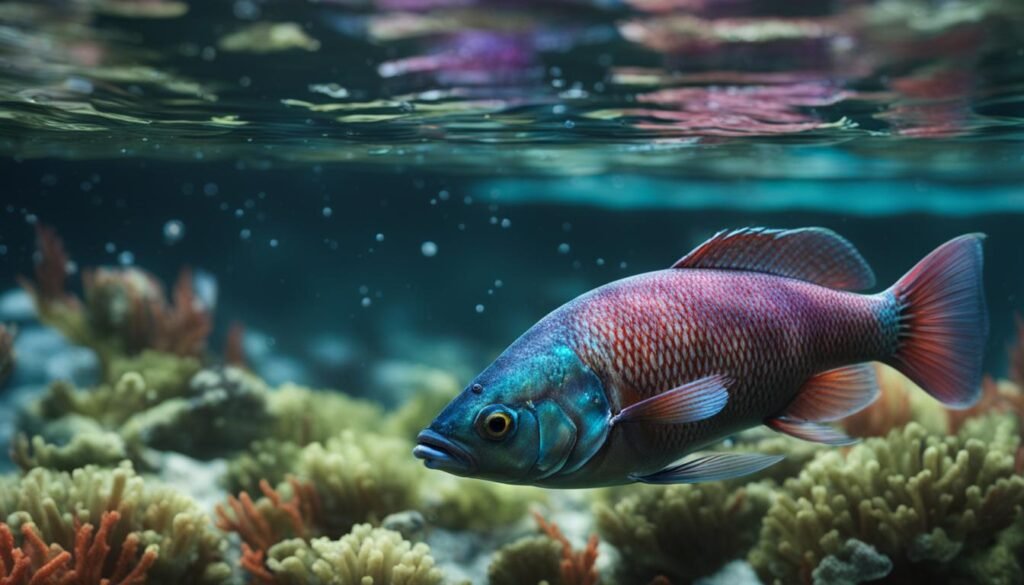
Fish employ a variety of strategies to remove waste from their bodies. One such method is through their gills, where they excrete nitrogenous waste in the form of ammonia. By passing water over their gills, fish filter out harmful substances and release waste back into the aquatic environment.
Another method of waste elimination in fish is through their skin. Some species of fish, such as certain types of catfish, excrete waste directly through their skin. This process, known as cutaneous respiration, allows for efficient waste removal in environments where gill filtration may not be sufficient.
Additionally, some fish species have specialized excretion organs called nephrons in their kidneys. These nephrons play a crucial role in the filtration and removal of waste materials from the bloodstream, ensuring the proper functioning of the fish’s internal systems.
Environmental Considerations of Fish Excretion
The excretion of waste by fish can have significant environmental impacts on aquatic ecosystems. Fish waste contains nutrients such as nitrogen and phosphorus, which are essential for the growth of algae and other aquatic plants. However, excessive nutrient levels can lead to eutrophication, an overgrowth of algae that depletes oxygen levels and harms other organisms in the ecosystem.
Furthermore, the deposition of fish waste on the substrate can contribute to the nutrient cycling process in the ecosystem. Decomposers break down the waste, releasing nutrients that are taken up by plants and other organisms. This cycling of nutrients helps maintain a balance within the ecosystem.
Understanding the unique methods of fish waste elimination and the environmental considerations associated with fish excretion is crucial for managing and preserving the health of aquatic ecosystems. By studying and monitoring fish excretion patterns, researchers and environmentalists can take necessary measures to mitigate negative impacts and promote the sustainability of our water systems.
The Art of Filtration in Aquatic Ecosystems
In aquatic ecosystems, filtration plays a crucial role in maintaining the delicate balance of the environment. Various organisms, including fish, contribute to the process of water filtration, ensuring the overall health and stability of the ecosystem.
Water filtration is essential for removing impurities and maintaining water quality. It helps to eliminate harmful substances, such as excess nutrients, sediments, and pollutants, which can have detrimental effects on aquatic life.
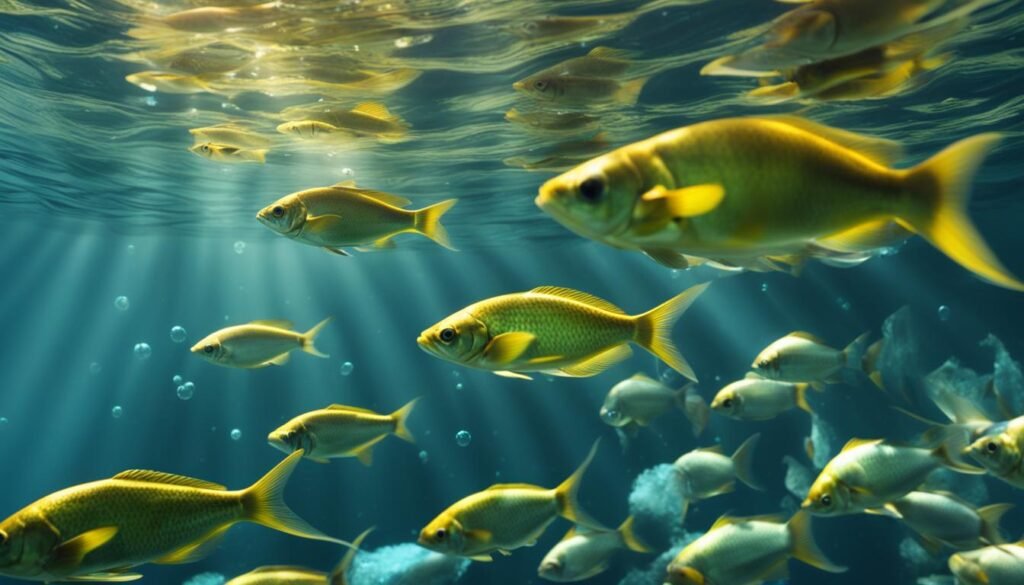
Fish, in particular, play a significant role in the filtration process. Their gills act as natural filters, removing particles and pollutants from the water as they breathe. The gill filaments contain tiny hair-like structures called cilia, which trap suspended particles and prevent them from entering the fish’s respiratory system.
Additionally, fish excretion also contributes to water filtration. As fish eliminate waste, nutrients are released into the water. These nutrients, such as nitrogen compounds, can be beneficial when present in appropriate quantities. They promote the growth of phytoplankton, which forms the base of the food chain in aquatic ecosystems.
The phytoplankton, in turn, produce oxygen through photosynthesis, benefiting other organisms in the ecosystem. However, excessive nutrients can lead to eutrophication, an overgrowth of phytoplankton that depletes oxygen levels and disrupts the balance of the ecosystem.
To maintain a healthy aquatic ecosystem, proper filtration is necessary. It helps to prevent the accumulation of pollutants, maintains oxygen levels, and promotes the growth of beneficial organisms. Filtration also supports the overall health and well-being of fish and other aquatic species.
In conclusion, filtration in aquatic ecosystems is an intrinsic part of maintaining a healthy and stable environment. Fish, with their natural filtration mechanisms, play a vital role in ensuring water quality and ecological balance. Understanding the art of filtration allows us to appreciate the complexity of aquatic ecosystems and highlights the importance of responsible stewardship.
Ammonia vs. Urea: Fish Nitrogenous Waste Explained
In this section, we will delve into the different types of nitrogenous waste produced by fish, specifically ammonia and urea. Understanding the complexities of fish nitrogenous waste will shed light on the excretory mechanisms of fish.
The Prevalence of Ammonia in Fish Waste
Ammonia is a common nitrogenous waste product in fish. It is mainly produced through the degradation of proteins and amino acids during metabolism. Fish excrete ammonia primarily through their gills and to a lesser extent through urine and feces. Ammonia is highly toxic and can be harmful to fish if not efficiently eliminated from their bodies.
How Different Fish Species Process Nitrogenous Waste
Various fish species have different methods of processing and excreting nitrogenous waste. Some fish, such as bony fish, eliminate ammonia as their primary waste product. They have well-developed gills that allow for efficient elimination of ammonia through diffusion. Other fish, such as cartilaginous fish like sharks and rays, convert ammonia into less toxic compounds like urea. These fish have specialized organs called rectal glands that help them excrete excess urea.
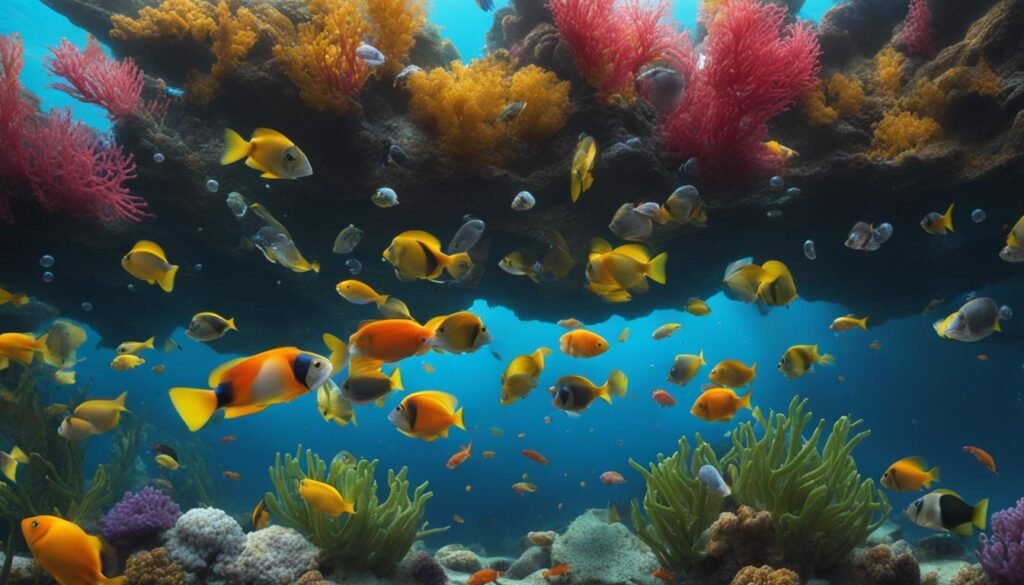
The image above provides a visual representation of the fish nitrogenous waste processing. It shows the different methods used by fish species to eliminate nitrogenous waste and maintain proper physiological balance.
Fish Behavior: How Urination Contributes to Aquatic Communication
In the intricate underwater world, fish behavior plays a crucial role in aquatic communication. Surprisingly, urination is one of the ways in which fish use their unique bodily functions to convey important messages to fellow fish. Let’s dive deeper into this fascinating topic and explore how urination contributes to the intricate language of fish.
When fish urinate, they release chemical signals called pheromones into the water. These pheromones carry valuable information about the individual fish, such as their gender, reproductive state, and social status. Other fish can detect and interpret these pheromones, allowing them to gather essential information about their environment and neighboring fish.
Interestingly, some fish species use urine as a way to mark their territory or establish dominance. By releasing urine in specific areas, fish communicate their presence and assert their ownership over a particular territory. This behavior helps maintain social hierarchies and minimize conflicts among fish populations.
Furthermore, urination in fish can also serve as a signal for breeding purposes. Female fish may release pheromones in their urine to attract males during mating seasons, signaling their readiness to reproduce. This chemical communication ensures successful reproduction and the continuation of the species.
“The unique ability of fish to communicate through urination highlights the complex and intricate nature of aquatic life.”
It is important to note that the precise mechanisms and purposes of fish urination are still being studied by scientists. The behavior and communication methods vary across different fish species, adding to the intrigue and diversity of aquatic life.
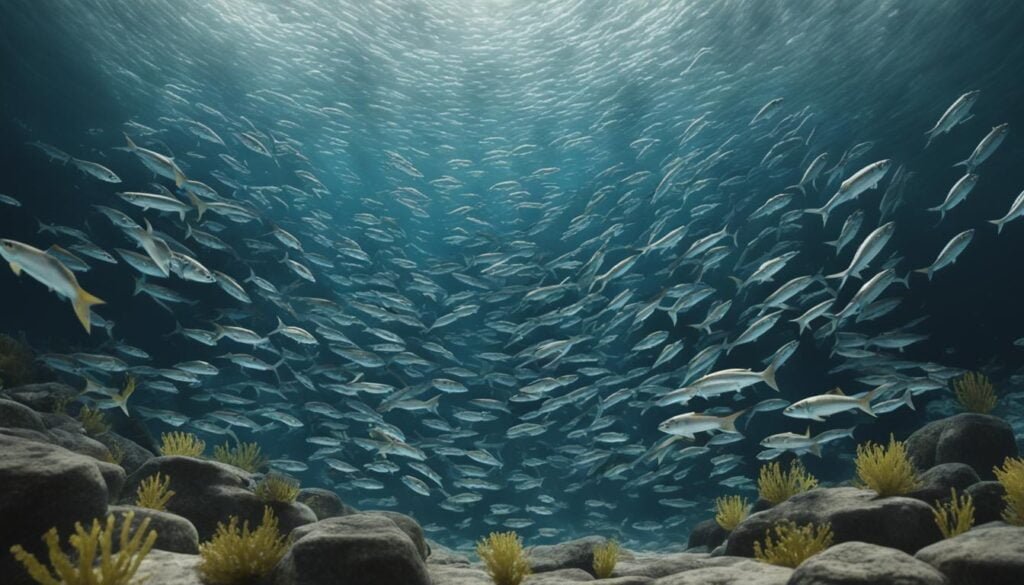
| Key Points |
|---|
| Fish behavior plays a crucial role in aquatic communication. |
| When fish urinate, they release pheromones that carry valuable information about their gender, reproductive state, and social status. |
| Some fish species use urine to mark their territory or establish dominance. |
| Urination in fish can also serve as a signal for breeding purposes, with females releasing pheromones in their urine to attract males. |
| The intricate nature of fish urination highlights the complexity of aquatic life and the importance of understanding fish behavior. |
By unraveling the mysteries of fish behavior and the role of urination in aquatic communication, we gain a deeper appreciation for the intricate and fascinating world beneath the surface of the water.
The Dynamic Fishbowl Ecosystem: Home for Aquatic Life
In a fishbowl, a confined aquatic habitat, a dynamic ecosystem thrives, providing a home for various aquatic life forms. The balance of this ecosystem is vital for the health and well-being of the fish that inhabit it. Understanding the intricacies of the fishbowl ecosystem is crucial for creating an environment that supports fish health and promotes ecosystem balance.
Creating Balance in a Confined Aquatic Habitat
Creating and maintaining balance in a fishbowl ecosystem is essential to ensure the overall health and survival of the fish. Several factors contribute to this balance, including water quality, nutrient levels, and the presence of beneficial microorganisms. Striking the right balance helps prevent the buildup of harmful substances and promotes a stable and thriving aquatic environment.
Oxygen, Temperature, Food: Key Elements for Fish Health
Providing adequate oxygen levels, maintaining suitable temperature conditions, and ensuring proper nutrition are crucial for the health of fish in a fishbowl ecosystem. Fish rely on dissolved oxygen in the water for respiration, and insufficient oxygen levels can lead to stress and even death. Monitoring and maintaining the water temperature within the appropriate range is vital to prevent temperature-related stress. Additionally, offering a balanced diet that meets the nutritional needs of the specific fish species is essential for their growth, development, and overall health.
Image:
Understanding the intricacies of a fishbowl ecosystem, from creating balance to providing essential elements for fish health, is the key to establishing and maintaining a thriving aquatic habitat. By fostering a healthy and balanced ecosystem, fish enthusiasts can create a beautiful and vibrant fishbowl environment that promotes the well-being of their aquatic companions.
Balancing the Fishbowl: The Role of Regular Maintenance
In order to keep your fishbowl balanced and ensure the well-being of your fish, regular maintenance is crucial. By following a consistent maintenance routine, you can create a healthy and stable environment for your aquatic pets.
Here are some essential tasks involved in fishbowl maintenance:
- Water changes: Regularly replacing a portion of the water in the fishbowl helps remove accumulated waste and maintain water quality. Aim for weekly water changes of around 25% to 50% of the total volume.
- Filter cleaning: Cleaning the fishbowl filter removes debris and ensures it continues to function efficiently. Check the manufacturer’s instructions for guidance on how often to clean the filter.
- Monitoring water parameters: Regularly test the water for parameters such as pH, ammonia, nitrite, and nitrate levels. This helps you identify any imbalances that may be harmful to your fish.
- Algae control: Keep an eye on algae growth in your fishbowl. Excessive algae can affect water quality and create an unsightly appearance. Consider using algae-eating fish or gently scrubbing off algae if necessary.
Regular maintenance not only helps maintain water quality and prevent potential health issues for your fish, but it also promotes the overall stability of the fishbowl ecosystem. By maintaining a clean and balanced environment, you can provide a thriving home for your aquatic companions.
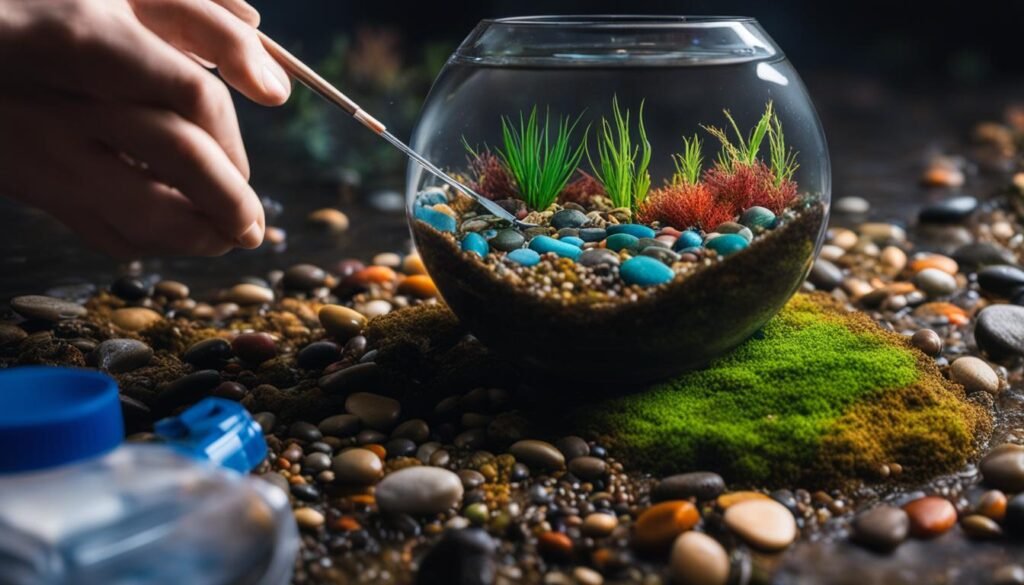
Raising Fry in a Fishbowl: Can Baby Fish Thrive?
In this section, we will discuss the challenges and considerations of raising fry, or baby fish, in a fishbowl. It’s an exciting endeavor that requires understanding the developmental needs of fish larvae and ensuring suitable conditions for fry growth.
Understanding Developmental Needs of Fish Larvae
When it comes to raising fry in a fishbowl, it’s crucial to understand the specific developmental needs of fish larvae. These tiny creatures require proper nutrition, suitable water parameters, and a conducive environment to grow and thrive.
Providing the right diet is essential for the healthy development of fry. Many fish species have specific nutritional requirements during their early stages, often needing specialized fry food or live foods such as brine shrimp or microworms. It’s important to research the nutritional needs of the specific fish species you are raising and provide a well-balanced diet to support their growth.
In addition to nutrition, water quality is crucial for fry development. Maintaining pristine water conditions, including the right temperature, pH levels, and low ammonia levels, is vital for their well-being. Regular water changes and filtration are necessary to ensure clean and healthy water for the fry.
Ensuring Suitable Conditions for Fry Growth
Creating a suitable environment for fry growth is key to their success. The fishbowl should provide enough space for the fry to swim and grow without overcrowding. It’s important to consider the size and number of fry you are raising to prevent competition for resources.
Providing hiding places, such as live plants or artificial decorations, can offer shelter for the fry and reduce stress. These hiding spots can also mimic their natural habitat and encourage natural behaviors.
Monitoring water parameters regularly and adjusting them as necessary is crucial for maintaining suitable conditions for fry growth. A good filtration system and reliable water testing kits are essential tools for ensuring optimal water quality.
Finally, closely observing the fry’s behavior and growth is essential. Keep an eye out for any signs of illness or stress, and act promptly to address any issues. Regular and attentive monitoring will help you make adjustments to their environment and ensure their continued well-being.
When raising fry in a fishbowl, providing the right developmental needs and suitable conditions is crucial for their survival and growth. By understanding their specific requirements and closely monitoring their well-being, you can create an environment where baby fish can thrive.
The Larger Impact of Fish Urination on Marine Ecosystems
In this section, we will delve into the larger impact of fish urination on marine ecosystems. Fish urine plays a crucial role in nutrient cycles in the sea, contributing to the overall health and balance of marine environments. Understanding the ecological significance of fish urination will shed light on the interconnectedness of marine ecosystems.
From Whale Urine to Coral Reefs: Nutrient Cycles in the Sea
One fascinating aspect of fish urination is its role in the nutrient cycles of the sea. Take, for example, whale urine. Whales release large amounts of urine containing nitrogen-rich compounds into the ocean. This urine serves as a source of nutrients for microscopic algae, which in turn support the entire food chain in the marine ecosystem. The growth of coral reefs is also influenced by fish urine, as it provides essential nutrients for the development and resilience of these unique and diverse habitats.
How Freshwater and Saltwater Fish Affect Their Surroundings
Both freshwater and saltwater fish contribute to the ecological dynamics of their surroundings through urination. Freshwater fish release urine that contains excess nutrients, such as nitrogen and phosphorus, into their aquatic habitats. This urine acts as a source of nutrients for algae and other organisms, impacting the overall nutrient balance of the ecosystem. In saltwater environments, fish urine plays a similar role, providing essential nutrients for the growth and productivity of marine plants and animals.
By understanding the impact of fish urination on marine ecosystems, we can recognize the intricate relationships between different species and the vital role they play in maintaining a healthy and balanced environment. Fish urination is not just a waste elimination process; it is a crucial component of nutrient cycles that contribute to the overall sustainability of our oceans.
| Freshwater Fish | Saltwater Fish | |
|---|---|---|
| Impact on Nutrient Cycles | Contribute excess nutrients to freshwater habitats | Provide essential nutrients for marine ecosystems |
| Role in Ecosystem Balance | Affects the nutrient balance and ecosystem productivity in freshwater environments | Supports the growth and productivity of marine plants and animals |
Note: The table above summarizes the key differences in the impact of fish urination between freshwater and saltwater environments.
Conclusion
In conclusion, the topic of fish urination and aquatic excretion has revealed fascinating insights into the natural water systems that surround us. Throughout this article, we have uncovered the significance of fish urination in maintaining the health and balance of aquatic ecosystems.
Understanding aquatic excretion is crucial for responsible stewardship of the environment. By gaining knowledge about fish urination, we can appreciate the intricate processes that enable fish to eliminate waste and contribute to the overall balance of natural water systems.
From the unique mechanisms of fish excretion to the role of fish kidneys and gills, we now have a deeper understanding of how fish eliminate waste. We have also explored the environmental considerations and the impact of fish waste on marine ecosystems.
As we emphasize the importance of understanding aquatic excretion, we are better equipped to support the well-being of fish and make informed choices that preserve the health and vitality of our natural water systems.
FAQ
Do fish urinate?
Yes, fish do eliminate waste through a process similar to urination. However, fish have unique methods of waste elimination beyond traditional urination.
What are the different mechanisms by which fish eliminate waste?
Fish eliminate waste through various mechanisms, including urination, diffusion through the gills, and filtration through the kidneys.
How does fish excretion differ from mammalian excretion systems?
Fish excretion differs from mammalian excretion systems in terms of the organs involved and the mechanisms used. Fish kidneys, for example, have different structures and functions compared to mammalian kidneys.
What is the role of the fish kidney in waste removal?
The fish kidney plays a vital role in removing waste from the body. It contains small structures called nephrons that filter waste products and regulate water and electrolyte balance.
How do fish gills contribute to waste disposal?
Fish gills serve as a primary waste disposal channel, removing waste products from the bloodstream and excreting them into the surrounding water through a process called gill filtration.
What are the environmental considerations of fish excretion?
Fish excretion, including urination, can have an impact on aquatic ecosystems. The release of waste products can contribute to nutrient cycles and affect the overall balance of the ecosystem.
How does fish waste elimination contribute to the filtration of aquatic ecosystems?
Fish, along with other organisms, play a crucial role in water filtration and maintaining the balance of aquatic ecosystems. Understanding the importance of filtration sheds light on the significance of fish waste elimination.
What types of nitrogenous waste do fish produce?
Fish produce nitrogenous waste in the form of ammonia and urea. The prevalence of ammonia in fish waste and the different ways fish species process nitrogenous waste are of interest in understanding fish excretory mechanisms.
How does urination in fish contribute to aquatic communication?
Fish use urination as a means of signaling and interacting with other fish. It plays a role in fish behavior and the fascinating world of aquatic communication.
What are the key elements for maintaining a healthy fishbowl ecosystem?
Oxygen, temperature, and food are crucial elements for ensuring fish health in a fishbowl ecosystem. Creating balance in a confined aquatic habitat is essential for the well-being of aquatic life.
What tasks are involved in maintaining a healthy fishbowl?
Regular maintenance tasks for a healthy fishbowl include water changes, filter cleaning, and monitoring water parameters. These activities help maintain the overall stability and well-being of the fishbowl ecosystem.
What considerations are important when raising fry in a fishbowl?
Raising fry, or baby fish, in a fishbowl requires understanding their developmental needs and providing suitable conditions for their growth. Ensuring an appropriate environment is crucial for the well-being and successful development of fry.
What is the impact of fish urination on marine ecosystems?
Fish urination, along with other factors, has a larger impact on marine ecosystems. From contributing to nutrient cycles to affecting coral reef growth, understanding the ecological significance of fish urination highlights the interconnectedness of marine ecosystems.
What is the significance of fish urination in natural water systems?
Fish urination is significant in maintaining the health and balance of natural water systems. Understanding aquatic excretion is important in responsibly stewarding aquatic environments and preserving their overall well-being.
Source Links
- https://petplanetdiaries.com/do-fish-pee-unveiling/
- https://www.scienceabc.com/nature/animals/do-aquatic-animals-urinate.html
- https://customcreative.store/2023/11/27/do-fish-pee/


